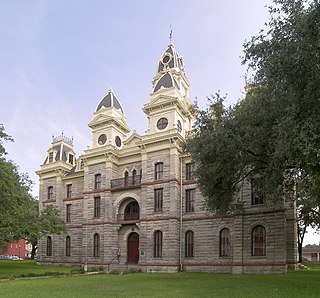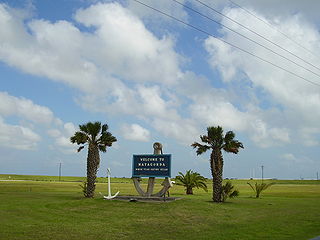
The Texas Revolution was a rebellion of colonists from the United States and Tejanos in putting up armed resistance to the centralist government of Mexico. While the uprising was part of a larger one that included other provinces opposed to the regime of President Antonio López de Santa Anna, the Mexican government believed the United States had instigated the Texas insurrection with the goal of annexation. The Mexican Congress passed the Tornel Decree, declaring that any foreigners fighting against Mexican troops "will be deemed pirates and dealt with as such, being citizens of no nation presently at war with the Republic and fighting under no recognized flag." Only the province of Texas succeeded in breaking with Mexico, establishing the Republic of Texas, and eventually being annexed by the United States.

Goliad County is a county located in the U.S. state of Texas. As of the 2010 census, the population is 7,210. Its county seat is Goliad. The county is named for Father Miguel Hidalgo; "Goliad" is an anagram, minus the silent H. The county was created in 1836 and organized the next year.

Goliad is a city in Goliad County, Texas, United States. It is known for the 1836 Goliad massacre during the Texas Revolution. It had a population of 1,908 at the 2010 census. Founded on the San Antonio River, it is the county seat of Goliad County. It is part of the Victoria, Texas, Metropolitan Statistical Area.

Martín Perfecto de Cos was a Mexican Army general and politician during the mid-19th century. Born in Veracruz, the son of an attorney, he became an army cadet at the age of 20, a lieutenant in 1821, and a brigadier general in 1833.

The Battle of San Jacinto, fought on April 21, 1836, in present-day Harris County, Texas, was the decisive battle of the Texas Revolution. Led by General Sam Houston, the Texian Army engaged and defeated General Antonio López de Santa Anna's Mexican army in a fight that lasted just 18 minutes. A detailed, first-hand account of the battle was written by General Houston from Headquarters of the Texian Army, San Jacinto, on April 25, 1836. Numerous secondary analyses and interpretations have followed, several of which are cited and discussed throughout this entry.

The flag of Texas is the official flag of the U.S. state of Texas. It is well known for its prominent single white star which gives the flag its commonly-used name: "Lone Star Flag". This lone star, in turn, gives rise to the state's nickname: "The Lone Star State." The flag, flown at homes and businesses statewide, is highly popular among Texans and is treated with a great degree of reverence and esteem within Texas.
The Convention of 1836 was the meeting of elected delegates in Washington-on-the-Brazos, Texas in March 1836. The Texas Revolution had begun five months previously, and the interim government, known as the Consultation, had wavered over whether to declare independence from Mexico or pledge to uphold the repudiated Mexican Constitution of 1824. Unlike those of previous Texas councils, delegates to the Convention of 1836 were younger, more recent arrivals to Texas, and more adamant on the question of independence. As delegates prepared to convene, Mexican President Antonio Lopez de Santa Anna led a large army into Texas to quell the revolt; the vanguard of this army arrived at San Antonio de Bexar on February 23.
This is a timeline of the Texas Revolution, spanning the time from the earliest independence movements of the area of Texas, over the declaration of independence from Spain, up to the secession of the Republic of Texas from Mexico.

The Goliad Campaign was the 1836 Mexican offensive to retake the Texas Gulf Coast during the Texas Revolution. Mexican troops under the command of General José de Urrea defeated rebellious immigrants to the Mexican province of Texas, known as Texians, in a series of clashes in February and March.

The Battle of Coleto, also known as the Battle of Coleto Creek, the Battle of the Prairie, and the Batalla del encinal del Perdido, was fought on March 19–20, 1836, during the Goliad campaign of the Texas Revolution. In February, General José de Urrea led a branch of the Mexican army up the Gulf Coast of Mexican Texas toward Goliad, where a large contingent of soldiers from the Texian Army were garrisoned under Colonel James W. Fannin. Simultaneously, Mexican president Antonio Lopez de Santa Anna led a larger force into the Texian interior, where on March 6 his troops won the Battle of the Alamo. After learning of the Alamo's defeat, Texian general Sam Houston ordered Fannin to retreat from Goliad and join the rest of the army in Victoria.

James Walker Fannin Jr. was a 19th-century American military figure in the Texas Army and leader during the Texas Revolution of 1835–36. After being outnumbered and surrendering to Mexican forces at the Battle of Coleto Creek, Colonel Fannin and nearly all his 344 men were executed soon afterward at Goliad, Texas, under Santa Anna's orders for all rebels to be executed.

The Battle of San Patricio was fought on February 27, 1836, between Mexican troops and rebellious immigrants from the Mexican province of Texas, known as Texians. The battle marked the start of the Goliad Campaign, the Mexican offensive to retake the Texas Gulf Coast. It took place in and around San Patricio.

The Battle of Agua Dulce Creek was a skirmish during the Texas Revolution between Mexican troops and rebellious colonists of the Mexican province of Texas, known as Texians. As part of the Goliad Campaign to retake the Texas Gulf Coast, Mexican troops ambushed a group of Texians on March 2, 1836. The skirmish began approximately 26 miles (42 km) south of San Patricio, in territory belonging to the Mexican state of Tamaulipas.
The Consultation served as the provisional government of Mexican Texas from October 1835 to March 1836 during the Texas Revolution. Tensions rose in Texas during early 1835 as throughout Mexico federalists began to oppose the increasingly centralist policies of the government. In the summer, Texians elected delegates to a political convention to be held in Gonzales in mid-October. Weeks before the convention and war began, settlers took up arms against Mexican soldiers at the Battle of Gonzales. The convention was postponed until November 1 after many of the delegates joined the newly organized volunteer Texian Army to initiate a siege of the Mexican garrison at San Antonio de Bexar. On November 3, a quorum was reached in San Antonio. Within days, the delegates passed a resolution to define why Texians were fighting. They expressed allegiance to the deposed Constitution of 1824 and maintained their right to form an independent government while this document was not in effect. Henry Smith was elected governor of the new provisional government and the remaining delegates formed a General Council. In the next weeks, the council authorized the creation of a new regular army to be commanded by Sam Houston. As Houston worked to establish an army independent from the existing volunteer army, the council repeatedly interfered in military matters.
This is a timeline of the Republic of Texas, spanning the time from the Texas Declaration of Independence from Mexico on March 2, 1836, up to the transfer of power to the State of Texas on February 19, 1846.

The Texian Army, also known as the Army of Texas and the Army of the People, was a military organization consisting of volunteer and regular soldiers who fought against the Mexican army during the Texas Revolution. Approximately 3,700 men joined the army between October 2, 1835, during the Battle of Gonzales through the end of the war on April 21, 1836, at the Battle of San Jacinto. After gaining independence the Texian Army would be officially known as the Army of the Republic of Texas. In 1846, after the annexation of Texas by the United States, the Army of the Republic of Texas merged with the US Army. Sam Houston became the new commander in chief of the new Texas army.
Philip Dimmitt (1801–1841) was an officer in the Texian Army during the Texas Revolution. Born in Kentucky, Dimmitt moved to Texas in 1823 and soon operated a series of trading posts. After learning that Mexican General Martín Perfecto de Cos was en route to Texas in the year 1835 (??) to quell the unrest, Dimmitt proposed that the general be kidnapped on his arrival at Copano. The plan was shelved when fighting broke out at Gonzales, but by early October, 1835, it had been resuscitated by a group of volunteers at Matamoros. Not knowing that Cos had already departed for San Antonio de Bexar, this group decided to corner Cos at Presidio La Bahia in Goliad. Dimmitt joined them en route, and participated in the battle of Goliad.
Rafael Antonio Manchola was a politician and military officer in Mexican Texas. He twice served as commandant of Presidio La Bahía. He served two terms in the legislature of the state of Coahuila y Tejas. At his behest, the community which had grown outside the fort was renamed Goliad and elevated in status to a villa. During his legislative service, Manchola also negotiated official boundaries for the colony of his father-in-law, Martín De León, and had a commissioner appointed to grant official titles to the settlers in that colony. After returning home, Manchola became the alcade of Goliad and initiated a resolution–then considered illegal– supporting the Constitution of 1824 and Mexican President Antonio Lopez de Santa Anna. He briefly attended the Convention of 1832 and volunteered to accompany William H. Wharton in journeying to Mexico City to request separate statehood for Texas. The mission was postponed, and Manchola died of cholera in late 1832 or early 1833.
Plácido Benavides (1810–1837) was an early Mexican-born settler in De Leon's Colony, Victoria County, Texas. Benavides earned himself the sobriquet of the Paul Revere of Texas for his 1836 journey from San Patricio to Goliad to Victoria, warning residents of the approaching Mexican army. He was twice elected alcalde of Victoria, Texas. He married into the powerful De León family, and with his wife Agustina became the father of three daughters. Benavides fought against the dictatorship of Antonio López de Santa Anna, but did not feel Texas should be separated from Mexico.















